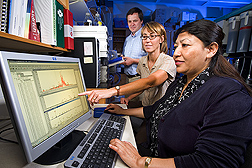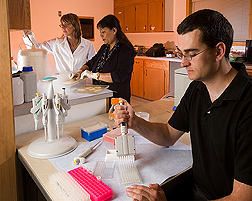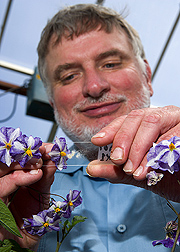Phytochemical Profilers
Investigate Potato Benefits
|
|
It’s no secret that the potato is America’s favorite vegetable. Indeed, U.S. consumers eat about 130 pounds of potatoes per person each year. Fried, baked, or mashed—it doesn’t matter: Americans love their spuds.
Now, this culinary love affair could grow even more passionate with Agricultural Research Service (ARS) findings that some potato varieties are chock full of beneficial plant compounds called “phytochemicals.”
Though not considered essential vitamins or nutrients, phytochemicals are thought to promote human health through a range of activity, such as by neutralizing cancer-causing agents and cell-damaging molecules called “free radicals.” Some phytochemicals, like soy’s isoflavones, are better known to consumers than others, like the phenolics found in most plants. Generally speaking, though, consumers associate phytochemicals with brightly colored fruits and vegetables or leafy green ones, like broccoli and brussels sprouts—but not potatoes.
“When people think ‘potato,’ they think of starch and carbohydrates,” comments Roy A. Navarre, a plant geneticist with the ARS Vegetable and Forage Crops Research Laboratory in Prosser, Washington. “But potatoes can actually be packed with phenolic compounds, which have a wide range of health-promoting properties, including antioxidant activity.”
Navarre knows of this firsthand, thanks to new analytical methods that he and colleagues have devised for detecting phytochemicals and their concentrations in potato skins and flesh. Joining Navarre in the effort are Charles R. Brown, an ARS plant geneticist at Prosser; Joanne Holden, an ARS biological science technician there; and research associates Roshani Shakya, at Washington State University, and Aymeric Goyer, at Oregon State University.
Team Tuber
So far, their scrutiny of 100 wild and commercially grown potatoes has turned up 60 different phytochemicals and vitamins. Among them are vitamin C, folic acid, chlorogenic acid, phenolics such as flavonoids, and kukoamines. These last compounds may help lower blood pressure and, prior to an Institute of Food Research (IFR) report in 2005, had only been found in the Chinese medicinal plant Lycium chinense. Navarre’s team, following up on the IFR work, used their new method to analyze more than five different kinds of kukoamines in locally grown potatoes.
Their research, begun in 2004, dovetails with a consumer trend in which one-third of the U.S. population is taking a daily vitamin or dietary supplement. Medical researchers, meanwhile, are hustling to better understand, as well as substantiate, the link between health and consumption of phytochemicals—whether from dietary supplements or from fruits, vegetables, legumes, or grains.
One question that would affect potato consumption is whether consumers could reap the purported benefits of a phytochemical like kukoamine from eating normal servings of varieties shown to contain it. The answer would hinge on medical science having first determined how much kukoamine is necessary for it to be biologically active.
|
|
Still, as a staple crop, the potato could be well suited to delivering such phytochemicals to consumers once the compounds’ roles are better defined, notes Navarre. Historically, though, breeding efforts have focused on improving crop productivity and resistance to pests rather than on elevating their nutrient content.
Flavonoids are of particular interest for their potential role in helping diminish risk of cardiovascular and other diseases, respiratory problems such as asthma, and certain cancers including prostate and lung types. Other flavonoids, such as anthocyanins in blueberries, act as antioxidants that scavenge free radicals before they can harm the body’s cells and tissues. The Prosser team’s analysis of potatoes has so far shown a 30-fold difference in flavonoid concentrations in specimens ranked from highest to lowest.
Quercetin, a flavonoid abundant in red onions, has caught the attention of the U.S. Department of Defense. In 2005, its Defense Advanced Research Projects Agency awarded $1.1 million to Appalachian State University to investigate quercetin’s potential to help maintain soldiers’ immune systems during deployments.
Though quercetin levels in potato are generally lower than those in onions, the tuber offers the advantage of being eaten more by consumers. And it’s possible that, in the course of the scientists’ potato profiling, a variety with an unusually high content of quercetin—or another flavonoid—may turn up.
|
|
Potent Potatoes
Investigations of phytochemicals in most crops, including potato, have been limited to one or two main varieties, Navarre says. And until recently, he adds, “We haven’t had a good idea of how much of these compounds is in potatoes or how the content varies from one variety to the next.”
The quest to find out has been made easier with his group’s recent development of a method that analyzes potato samples in 12 minutes using high-throughput liquid chromatography and mass spectrometry. From such analysis of wild and cultivated potatoes, for example, the team detected phenolic concentrations of 100 to 675 milligrams per 100 grams of dry weight. Phenolic levels in All Red and Norkotah potatoes were especially high, rivaling those in broccoli, spinach, and brussels sprouts.
Mindful of the importance of folic acid to proper fetal development, Navarre’s team has sought to identify potato germplasm sources containing high concentrations of this critical member of the vitamin B complex. All told, they examined 70 types of potatoes, finding a nearly threefold difference between high- and low-folic-acid specimens. Before the team’s profiling efforts, only six varieties had been scrutinized for folic acid.
“We looked at the expression of four genes involved in folate metabolism to see whether we can determine why one variety has more of this compound than another,” Navarre says.
Eventually, the results of such profiling will be publicly available. Potato breeders and distributors, for example, could use the information to explore new consumer markets for the crop or even develop entirely new varieties based on the dietary findings of nutritional science.—By Jan Suszkiw, Agricultural Research Service Information Staff.
This research is part of Plant Genetic Resources, Genomics, and Genetic Improvement (#301) and Plant Biological and Molecular Processes (#302), two ARS national programs described on the World Wide Web at www.nps.ars.usda.gov.
Duroy A. Navarre and Charles R. Brown are at the USDA-ARS Vegetable and Forage Crops Research Laboratory, 24106 North Bunn Rd., Prosser, WA 99350; phone (509) 786-9261 [Navarre] (509) 786-9252 [Brown]; fax (509) 786-9277.
"Phytochemical Profilers Investigate Potato Benefits" was published in the September 2007 issue of Agricultural Research magazine.










